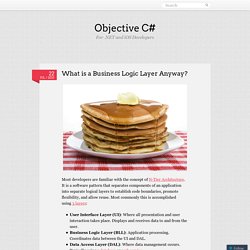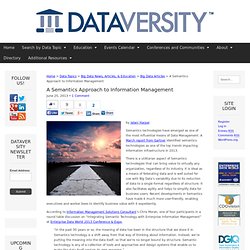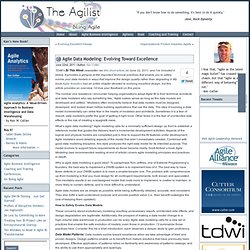

What is a Business Logic Layer Anyway? Most developers are familiar with the concept of N-Tier Architecture.

It is a software pattern that separates components of an application into separate logical layers to establish code boundaries, promote flexibility, and allow reuse. Most commonly this is accomplished using 3 layers: User Interface Layer (UI): Where all presentation and user interaction takes place. Displays and receives data to and from the user.Business Logic Layer (BLL): Application processing. Coordinates data between the UI and DAL.Data Access Layer (DAL): Where data management occurs. The UI and DAL are pretty easy to understand, but there is no clear definition for what a BLL should actually look like. Some people recommend designing your BLL by simply thinking of your application without a user interface. The goal is to centralize as much common logic as possible in the BLL so that it is not coupled to any particular UI. The same thinking applies for the BLL’s relationship to the DAL! Database Refactoring.
Microsoft Word - wp_agile_d4 - World Class Enterprise Architecture. Web database builder for cloud databases - Ragic. Dabble DB Blog Archives: Features. “Can I create a lookup field in a table to be viewed in another table?”

“I am a seasoned Access user and thought this would be a breeze --but I'm just not getting it. Your advertisements say that this is a relational database, but I don't see how I build queries, make join relationships, etc…Please help!” From time-to-time we receive emails from customers that would like to build a relational database in Dabble DB. In a typical database program, a relational database organizes your data into tables that are joined to each other by the specific data in each table. While Dabble is “relational”, our system differs from that of other traditional databases that some of our customers have become familiar with. If we look at Access, their relational database is comprised of multiple tables, each relating to a specific topic. One Category lists patients in a hospital. Category A And, the other Category contains a list of doctors. Category B Tell the system which category you want to link to.
E2E: Business Middleware. A Semantics Approach to Information Management. By Jelani Harper Semantics technologies have emerged as one of the most influential means of Data Management.

A March report from Gartner identified semantics technologies as one of the top trends impacting information infrastructure in 2013. There is a utilitarian aspect of Semantics technologies that can bring value to virtually any organization, regardless of its industry. It is ideal as a means of federating data and is well suited for use with Big Data’s variability due to its reduction of data to a single format regardless of structure. It also facilitates agility and helps to simplify data for business users. According to Information Management Solutions Consultant’s Chris Moran, one of four participants in a round table discussion on “Integrating Semantic Technology with Enterprise Information Management” at Enterprise Data World 2013 Conference & Expo, “In the past 30 years or so, the meaning of data has been in the structure that we store it in.
Triple Play Storage and Agility. The Clean Architecture. Over the last several years we’ve seen a whole range of ideas regarding the architecture of systems.

These include: Hexagonal Architecture (a.k.a. Ports and Adapters) by Alistair Cockburn and adopted by Steve Freeman, and Nat Pryce in their wonderful book Growing Object Oriented Software Onion Architecture by Jeffrey Palermo Screaming Architecture from a blog of mine last year DCI from James Coplien, and Trygve Reenskaug. BCE by Ivar Jacobson from his book Object Oriented Software Engineering: A Use-Case Driven Approach Though these architectures all vary somewhat in their details, they are very similar.
Each of these architectures produce systems that are: Independent of Frameworks. The diagram at the top of this article is an attempt at integrating all these architectures into a single actionable idea. The Dependency Rule The concentric circles represent different areas of software. The overriding rule that makes this architecture work is The Dependency Rule. Entities Use Cases Conclusion. Agile Data Modeling: Evolving Toward Excellence. TDWI’s BI This Week newsletter ran this short article on June 22, 2011, and I’ve included it below.

It provides a glimpse at the important technical practices that enable you to safely evolve your data models in ways that improve the design quality rather than degrading it. My book Agile Analytics has an entire chapter devoted to evolving excellent design, but this article provides an overview. I’d love your feedback on this piece. The number one resistance I encounter helping organizations adopt Agile BI is from technical architects and data modelers who say something like, “Agile makes sense as long as the data models are developed and settled.”
Modelers often incorrectly believe that data models must be designed, developed, and locked down before building applications that use the data.